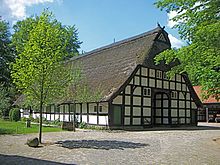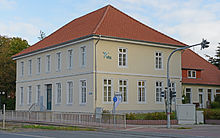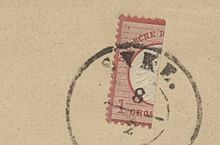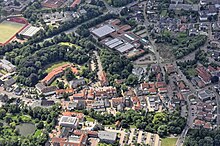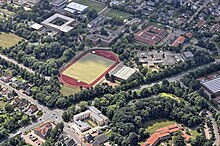Syke
| coat of arms | Germany map | |
|---|---|---|
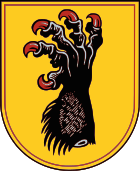
|
Coordinates: 52 ° 55 ' N , 8 ° 49' E |
|
| Basic data | ||
| State : | Lower Saxony | |
| County : | Diepholz | |
| Height : | 22 m above sea level NHN | |
| Area : | 127.93 km 2 | |
| Residents: | 24,295 (Dec. 31, 2019) | |
| Population density : | 190 inhabitants per km 2 | |
| Postal code : | 28857 | |
| Primaries : | 04242, 04240, 04248 | |
| License plate : | DH, SY | |
| Community key : | 03 2 51 041 | |
| LOCODE : | DE SYK | |
| City structure: | 13 districts | |
City administration address : |
Hinrich-Hanno-Platz 1 28857 Syke |
|
| Website : | ||
| Mayoress : | Suse Laue ( SPD ) | |
| Location of the city of Syke in the district of Diepholz | ||
Syke [ ˈziːkə ] is a town in Lower Saxony and a medium-sized center in the north of the Diepholz district .
“Syke” (old spelling “Siek”) is derived from Siek ( Low German for source reason). The name is pronounced by locals with a long “ie” and not like “Süke”, because “Süke” [ ˈzyːkə ] means plague or disease in Low German .
geography
Geographical location
Syke is the largest city and third largest municipality in the Lower Saxony district of Diepholz . It is located in the east of the Wildeshauser Geest Nature Park , about 19 kilometers (as the crow flies ) south of Bremen. The city is traversed by the Hache . As a “city in the country”, Syke is characterized by the approximately 900 hectare state forests Friedeholz and Westermark , which not only locals visit when the weather is nice.
Syke lies in a moraine landscape with wooded heights and ice age valleys. To the northwest of the village lies the Hohe Berg . The city was on an army route between Verden and Wildeshausen . Islands in the wide Hachetal made a transition possible here. A boardwalk was built. A dam was built where the “main street” in Syke runs today.
climate
There is a moderate maritime climate influenced by humid northwest winds from the North Sea. In the long-term mean, the air temperature in Syke reaches 8.5 to 9 ° C and around 700 mm of precipitation falls. Between May and August, an average of 20 to 25 summer days (climatological term for days on which the maximum temperature exceeds 25 ° C) can be expected.
City structure
- Barrien (4,977)
- Gessel (2,187)
- Godestorf (411)
- Heiligenfelde (1,452)
- Henstedt (452)
- Jardinghausen (312)
- Uncle (1,119)
- Osterholz (364)
- Ristedt (1,323)
- Schnepke (444)
- Steimke (819)
- Syke (center) (11,108)
- Wachendorf (513)
(Population of all districts as of January 1, 2017)
history
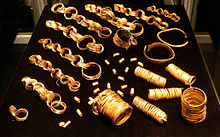
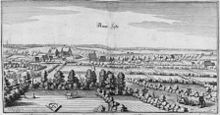
Prehistoric times
The Geest between the Hunte and the Weser (mainly the Delmenhorster area , but also the Syker Geest area ) is an old settlement area with a long history of settlement . Finds from the Stone Age , Bronze Age and Iron Age are exhibited in the District Museum in Syke , the Heimatmuseum Nienburg and the Focke Museum in Bremen. In 2011, the Bronze Age gold hoard of Gessel was found in the Feldmark near the Gessel district as one of the largest prehistoric gold hoards in Central Europe . The discovery was made during archaeological surveys before the construction of the NEL gas pipeline. Already in pre-Christian times the heights on both sides of the Hache valley were populated by Germanic farmers - Angrivarians and Chauken . In other archaeological investigations, a Germanic burial ground from the Roman Empire in the 2nd and 3rd centuries was discovered near Gessel .
From 300 AD, Saxons immigrated to the region. They organized the region politically in Gaue with thing constitutions . The northern area between the rivers Hunte and Weser became Largau and Lerigau . During the Carolingian era , the important Hache crossing in Syke was secured as a ring wall.
middle Ages
Around 800 AD, Saxony was conquered by the Franks under Charlemagne and the population was forced to become Christian . The worldly power of things passed on to the counts . The Largau became the county of Oldenburg-Wildeshausen. An Oldenburg count from the Bruchhauser line built a castle around 1270 to protect his interests against the Bremen bishops. Since then Syke has been the seat of the count's bailiffs and officials and the castle complex was expanded and strengthened to become the administrative seat after Syke fell to the rule of Neubruchhausen in 1259 . The earliest written mention of the castle comes from the last third of the 14th century. In 1384 it became the property of the Counts of Hoya, and in 1582, after the dynasty of the counts died out, it passed into the hands of Guelph dukes. In 1633, during the turmoil of the Thirty Years' War , the facility is said to have been partially razed .
The castle was built within the Syker ring wall with a circumference of around 400 meters. The oldest finds are ascribed to the 13th century.
The castle terrain offered space for 18 buildings, from the pigsty to the renaissance building of the large main house. It was enclosed by two moats and could only be reached via a drawbridge. The Kornzinshaus on the castle grounds is said to have been built in 1592 and is the oldest secular building in the Syker city area. The once multifunctional building also served as a warehouse, living room, bakery and brewery and had a beer and wine cellar. The grain was stored on several grain floors and flowed to the administration as tithe, landlord or court levy. An inscription in the north gable that adorned a fireplace until around 1850 and inventories from the 17th century show that it owes its creation to the Brunswick-Lüneburg Duke Philipp Sigismund , Bishop of Verden and Osnabrück . The duke ruled over the administrative district of Amt Syke from 1589 to 1623 . In the 1850s, the originally almost 33 meter long grain house was shortened. In addition, the upper floor, which mainly consists of half-timbered buildings, was removed.
As a result of the deposition of the Guelph Duke Heinrich the Lion by the Staufenkaiser Barbarossa , the county of Hoya was established on the Weser around 1200 . The Counts of Hoya soon moved their residence to Nienburg and acquired land west of the Weser, including Syke.
The current version of the name appears in the Weser Bridge List from around 1225, which mentions the place for the first time. The spelling has changed several times. Sycke is on a map from 1768 to 1773 , while the Siek field is to the west and the Syker vineyard to the north .
The plague raged in 1350 and 1464 , which only a few residents of Syke survived. In 1423 Syke was sacked by the Oldenburg counts. 1520 became Syke Flecken . In 1525 the Reformation reached the place.
Modern times
In 1582 the orphaned county fell to the dukes of Celle-Lüneburg . They were electors from 1692 to 1815 (Braunschweig-Lüneburg or Hanover) and until 1866 kings of the Kingdom of Hanover .
During the Thirty Years' War (1618-1648) was in 1628 by troops of the Catholic League under the commander Tilly sacked . The Danes and the Catholic League also devastated the place.
In 1718 Syke was granted market rights . In the same year Syke fell victim to a fire caused by lightning strikes. In 1740 Syke became a post office with a relay station .
During the occupation by the French under Napoleon (1803-1813), the territory on both sides of the Weser with Syke belonged to France . For Napoleon's Russian campaign , Syker were recruited for the French Grande Armée . During the billeting of French soldiers on April 2, 1808, 83 buildings burned down in Syke, only a few houses were spared from the fire.
In 1866 Syke became Prussian as part of the Province of Hanover . In 1885, the Syke district was formed by amalgamating the Freudenberg and Syke offices and became the seat of a district administrator.
From 1873 Syke got its station with the construction of the Osnabrück – Bremen line as part of the Hamburg – Venloer railway . In 1900 a narrow-gauge railway was built to Hoya , which was not switched to standard gauge until 1965.
The village of Syke was on the western bank of the Hache: on the eastern bank of the Hache was the colony of Syke, which had emerged from a rural settlement founded in 1790. In 1897 the Syke colony was merged with the Syke town. In 1929 Syke received city rights. In 1900 Syke had 2000 inhabitants.
As a result of the Prussian administrative reform of 1932, Syke became the district town of the newly formed county of Grafschaft Hoya , which arose from the amalgamation of the district of Hoya and the district of Syke. In 1946 Syke became part of the newly founded state of Lower Saxony . With the wave of refugees after the Second World War , the number of inhabitants doubled in 1945. In 1974, today's town emerged from the previous town of Syke and twelve previously independent suburbs. Syke was the county seat of Hoya County until 1977 . After the district reform in 1977/78 there was a large branch of the administration of the district of Diepholz in Syke. In 2004 the district centralized its administration in Diepholz . Other authorities and institutions have settled in the former Syker district building. Today there is also a branch of the Syker high school there.
The vehicle hall of the fire station in the Syke urban area burned down completely in December 1994 and again in January 2009.
The license plate of the district county Hoya was SY . After the administrative reform in 1977 this district was divided between the districts of Nienburg, Oldenburg and Diepholz. Since the former county of Hoya County is predominantly agricultural, you can occasionally come across vehicles or trailers used for agriculture that still bear the SY license plate. The SY license plate has been issued again since April 2018.
Incorporations
On March 1, 1974, the communities Barrien , Gessel , Gödestorf , Heiligenfelde , Henstedt , Jardinghausen , Okel , Osterholz , Ristedt , Schnepke , Steimke and Wachendorf were incorporated and are still districts of Syke.
Population development
|
|
(1961 on June 6th and 1970 on May 27th, each within the current limits, from 1987 on each December 31st)
politics
City council
New local parliaments were elected in Lower Saxony on September 11, 2016 . The Syker city council has 31 seats (including the mayor). According to the official final result, the new city council is composed as follows:
mayor
Suse Laue has been Mayor of Syke since September 26, 2013. She is a member of the SPD , but ran as an independent candidate, supported by the SPD, the Greens and the SYKEplus electoral community. She won the mayoral election on September 22, 2013 with 54.3% against three competitors. The turnout was 72.2%.
- Previous incumbents of the city
- ~ 1820 (almost 30 years): Arthur Christoph Fricke
- 1932-1937: Friedrich Rittmeister
- 1937-1945: Bodo Habild
- 1941 - 1945: Acting Mayors: Johann Wrede, Friedrich Jürgens
- 2001 - 2013: Harald Behrens (FDP)
- since 2013: Suse Laue (SPD)
coat of arms
Blazon : The coat of arms of the city of Syke shows an upright black bear paw with red claws on a gold background. The motif is derived from the coat of arms of Count von Hoya and can also be found, for example, in the coat of arms of the district of Diepholz and the cities of Bassum , Bruchhausen-Vilsen , Hoya and Sulingen .
Partnerships and sponsorships
- In the 1950s, Syke sponsored former residents of the former district town of Wehlau ( Snamensk since 1946 ) in East Prussia . In the Syker district museum there is a "Wehlauer Heimatstube" with corresponding exhibits. A home meeting takes place here every year.
- Since 1973 Syke has had a town partnership with the French canton La Chartre-sur-le-Loir in the Sarthe department .
- Since 2006 there has been a twinning with the Polish city of Wąbrzeźno in north-central Poland, about 50 km northeast of Toruń in the Kuyavian-Pomeranian Voivodeship .
- Since the early 1990s there have been friendly contacts with the Polish city of Brodnica , which is also in the Kuyavian-Pomeranian Voivodeship.
- The Syke grammar school maintains regular student exchanges with the grammar school in Brodnica and the Russian city of Nizhny Novgorod .
- Syke is represented in the Lower Saxony / Bremen municipal association.
Culture and sights

Theater and music
- The Syker Theater on La-Chartre-Strasse was completed in 1964 as part of the Syke grammar school. It has 589 seats and does not have its own ensemble.
- The modern orchestra Syke is one of the few symphonic wind orchestras in northern Germany. It has won numerous prizes in international musical competitions and regularly organizes concerts in the region. A cultural highlight is the annual concert in the theater on La Chartre Street.
- The cultural initiatives Jazz Folk Klassik in Syke e. V. and Rüttelschuh in der Wassermühle e. V. regularly organize concerts with a focus on jazz, folk, blues, classical music and songwriters. Based on the Syker Songtage , which took place in the 1970s, a new festival concept Jazz Folk & Bike Syke was developed in 2003 , which was awarded the Lower Saxony Tourism Prize in 2004.
- The choral society "Germania" Syke from 1846 was dissolved in 2015.
Museums
- The district museum in Syke (exit towards Bremen , to the left of Bundesstraße 6 ) is a local history and open-air museum . The exhibition focuses on handicrafts, rural production methods, housekeeping, cultural history, prehistory and early history and natural history. The museum has existed since 1937 and was created from a farmhouse built in 1747.
- The privately operated Henstedt village museum is in the Henstedt district . Here, exhibits related to the location are displayed. The village museum also includes an originally furnished air raid shelter , which was used by several families until 1945.
art
- The Syker Vorwerk - Center for Contemporary Art is located in one of the oldest houses in Syke, the official residence of the Vorwerk . The Vorwerk was spun off from the Amtshof in 1580 and built on the edge of the Friedeholz. Around 1790 the Vorwerk was almost completely dissolved and most of the buildings demolished. Relics of the extensive farm yard are the official residence from 1728, the brewery from 1736 and the coach house from 1783. Today's Vorwerk used to be the residence of the officials of the Syke office and, in more recent times, the respective district administrators and chief district directors of the Hoya district and later the Diepholz district . In 2002, after the last senior district director moved out of the. The listed building was taken over by the non-profit foundation Kreissparkasse Syke , renovated and opened in September 2007 as a center for contemporary art . The exhibition area covers 400 m² on two floors. Alternating between thematic group exhibitions and solo exhibitions, works by contemporary artists from home and abroad as well as from the region are shown. The collection of the Syker Vorwerk has so far included works by the Syker sculptor Louis Niebuhr and his wife Beate Zitzlaff as well as 60 pictures by the Diepholz and Düsseldorf artist Hans-Albert Walter . Both artists are winners of the Diepholz District Culture Prize .
Buildings
The well-known buildings in Syke include the Vorwerk and the Syke Amtshof with the remains of a medieval ring wall and the Kornzinshaus from 1592. Inside the Amtshof is the seat of the Syke District Court .
The Evangelical Lutheran Christ Church, which defines the cityscape, is located directly on Bundesstraße 6.
At the west entrance, the villa-like residential building of the well-known Finkenburg on the Finkenberg is visible.
City Archives
The City Archives are the city's administrative archives . Files, cards , documents , bequests and old editions of the regional newspapers are available in the city archive . These unique pieces - this cultural asset - are housed in the town hall, Hinrich-Hanno-Platz 1.
Jewish Cemetery
The Jewish cemetery in Syke is a cultural monument . It is one of eight well-preserved Jewish cemeteries in the Diepholz district. In the cemetery between Hohe Straße and Lindhofhöhe there are 35 tombstones from 1836 to 1935.
Nature reserves
- In Barrien , in Gessel and in Schnepke there are Schlatts , small biotopes under nature protection .
- There are six designated nature reserves (NSG) in the Syker urban area :
- NSG Schnepker Schlatt (HA 6; 5 ha)
- NSG Okeler Sandgrube (HA 160; 3.6 ha)
- NSG Boltenmoor (HA 181; 13.3 ha)
- NSG Wachendorfer / Gödestorfer Bruch (HA 199; 195 ha)
- NSG amphibian biotope Friedeholzer Schlatt (HA 206; 18.8 ha)
- NSG Hachetal and Freidorfer Hachetal (HA 248; 261.8 ha)
Architectural monuments
There are 109 monuments in Syke . For the restoration of a farm building of the former post office , the private initiative “Rund ums Syker Rathaus e. V. “2011 was awarded the Lower Saxony Prize for Civic Engagement.
Forests and parks
To the east of the city center of Syke is the Friedeholz , a state forest mainly occupied by beeches and large, strongly scented Douglas firs . In the forest there is a Bronze Age barrow field . In 2010, on an area of 4.5 hectares in Friedeholz 2500 sycamore planted seedlings. Southwest of Syke is the Westermark State Forest with an adventure playground.
There are two parks in the Syker core area: the Mühlenteichpark and the Europagarten . The park-like mill pond area exists in the Barrien district of Syker .
- In Edgar-Deichmann-Park, named after a Syker honorary citizen, directly on the Hache , there has been at least one specimen of each of the tree species listed in the Tree of the Year list since 2006 . These trees are marked. Until October 2016 it was called Mühlenteichpark.
- The Europagarten on the Zum Hachepark street sees itself as an art and cultural project. It is a combination of a biotope, various works of art by Syker artists and a concert shell . It is a joint project of the city of Syke, Syker artists, the Europa-Union Kreisverband Diepholz and the BUND ; it is, as it were, a total work of art with a multifunctional character: art - culture - nature.
- The Barrier Mühlenteich area south of the local watermill with a circular path, the Heinrich-Schmidt-Barrien-Weg , is a wildlife park with its wild growth and a circular path that offers views of Barrien, into the Hachetal to Syke and Gessel.
- Between the Syker Friedeholz and Barrien behind a furniture store located since 2014, about two hectares large Arboretum Syke with nearly 70 trees mostly native species.
Art in public space
There are many different sculptures and objects in Syke :
- In the forum of the Hacheschule there are murals / picture objects by the Schweringen artist Gottlieb Pot d'Or (1905–1978) from 1966
- The mural Knight and Abbess (metal with enamel ; around 1970) by Gottlieb Pot d'Or is in the Syke district building . The saddlecloth of the horse on which the knight sits bears the coat of arms of the communities in what was then the county of Hoya .
- On the “Steinwiese” ( stone square ) at the grammar school there are six marble sculptures , which were made by six renowned sculptors from five nations ( Miguel Ausili , Italy; Ioanna Filippidu , Greece ) as part of the 1991 Sculpture Symposium in Syke under the title Forms for Europe - Forms of Stone ; Janez Lenassi , former Yugoslavia; Louis Niebuhr , Germany; Jiri Seifert , former Czechoslovakia; Werner Stötzer , Germany).
- The marble sculpture Non-Stop by Syker Louis Niebuhr has been standing on the site of the former district administration in front of the Tourist Office (Kornzinshaus) since 1996 . It was created in 1988 on the occasion of the International Sculptor Symposium in Berlin.
- The bronze sculpture Guardian (1994) and the relief body Stadtleben (1995) by Syker Andreas Frömberg are located in downtown Syker .
- In Syker Friedeholz there is the art area Forest-Weg -zeichen with art objects made of wood by Regine Hawellek ( Zwei , 2006), Ulrike Gölner ( Die Welle , 2007), Adam ( hand signals ), Pablo Hirndorf ( aRound , 2010), Reinhard Osiander ( Hirsch , 2011), Markus Keuler ( forest diver , 2012), Uwe Schloen ("Gas Station", 2015). The Fantasieplatz (2005) by Syker Detlef Fritz Voges with 23 colored objects made of Douglas fir is also one of the forest path signs . The art installation is for large and small people to walk, touch, look at and think about. The objects double delta and core cuts polar - bipolar (2001) by Louis Niebuhr and characters (2003) by Eckhard Wesche (1947–2011) have been dismantled for safety reasons.
- A bronze bear group by Holger Voigts (1987) stands on the Mühlendamm in front of the Kreissparkasse .
- On the town hall square in front of the Christ Church there is a memorial (Stahl, 1999) by Elsa Töbelmann and Henning Greve for the persecuted and murdered Jewish fellow citizens of Sykes.
- Six objects by Rita Bieler ( Steinhaus , 1992), Heidrun Kohnert ( Tor , 1996), Heike Michaela Walter (three individual objects, 1998), Erika Harjes ( Get Into Conversation , 2003) are on the premises of the District Museum on Bundesstraße. and Anke Nesemann ( horse head , 2005). In addition to the so-called Krendel, there is an installation made of oak (2001) by Nicola Dormagen, which consists of numerous individual elements and is reminiscent of oversized children's building blocks.
- There is a bronze sculpture by Jürgen Cominotto and a stone sculpture by Karl Wientzek (both 1984) on the premises of the tax office .
- There is a fountain with stone balls (1984) in front of the Oldenburgische Landesbank in Hauptstrasse .
- In the Barrier Cemetery there is a steel sculpture (2005) by Elsa Töbelmann and Henning Greve in memory of the 25 babies of Eastern European foreign workers. The babies died in 1944/45 in a so-called “Polish children's home” that the National Socialists had set up in Barrien and were buried in the Barrier Cemetery.
- Wood and ceramic sculptures by the following artists can be seen on the grounds of the “Syker Vorwerk”: Rita Bieler: Wegzeichen Wiese, Park und Garten (Terracotta, 2003), Heike Michaela Walter: Bienenbeet (installation of 5 terracotta objects and a flowerbed , 2010), Emmanuel Eni : Blatt Geist Totem (Douglas fir, terracotta, mirror glass, 2011) and Detlef Fritz Voges: Der Amtmann (Douglas fir, colored, 2011).
Stamp
The Syke halving is a philatelic peculiarity from 1872/73. It is traded among philatelists for up to € 261,000.
Economy and Transport
Established businesses
Important branches of industry include mechanical engineering and laboratory technology. Other companies deal with the natural stone wholesaling, house building and cattle exploitation. Syke is also the seat of regional authorities. The publishing and printing house of the Kreiszeitung Verlagsgesellschaft is located in Syke , a central hub in Dirk Ippen's branched newspaper empire .
traffic
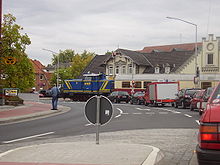

- Syke can be reached via the federal highway 6 between Bremen and Hanover or the federal highway 1 (Hansalinie) at the exits Groß-Mackenstedt, Brinkum or Weyhe.
- The Bremen airport is 20 km away.
- Syke is on the Wanne-Eickel-Hamburg railway line . Regional Express trains on line RE 9 Osnabrück -Bremen- Bremerhaven -Lehe and the regional S-Bahn Bremen / Lower Saxony on line RS 2 (Bremenhaven-Lehe-Twistringen) stop at Syker's largest station . At the Syke-Barrien stop, the regional S-Bahn Bremen / Lower Saxony stops on the RS 2. In the future, the regional S-Bahn Bremen / Lower Saxony will run every 30 minutes from Syke to Bremerhaven-Lehe. The Syker train station has the highest number of passengers in the district, with 3200 people getting on and off every day.
- The line from Syke to Eystrup was repaired in 2006/07 between the Syker train station and the Syke-Heiligenfelde district . Since 2007, the Kaffkieker has been operating as a tourist train between Syke and Eystrup on a few days a year and is operated by Verkehrsbetriebe Grafschaft Hoya (VGH) in cooperation with the German Railway Association and the Mittelweserbahn . Small freight trains also run here. The level crossings on the line were equipped with modern safety technology in July / August 2008, which was approved by the Federal Railway Authority on October 9, 2008.
- During the Brokser marriage market, trains of the railways and transport companies Elbe-Weser run on the route .
- The city area is traveled by bus from the Syker citizen bus , which runs here on three lines.
- In June 2005 Syke was voted the most bicycle-friendly municipality in Lower Saxony.
Infrastructure
General

- Town hall Syke (city administration) with citizens' office, Hinrich-Hanno-Platz 1
- Syke City Library, Hinrich-Hanno-Platz 1
- The Syke volunteer fire brigade consists of ten local fire brigades: Syke fire brigades and four base fire brigades in Barrien, Gödestorf-Osterholz-Schnepke, Heiligenfelde and Ristedt and five fire brigades with basic equipment in Gessel, Henstedt, Jardinghausen, Okel and Wachendorf.
- THW local branch Syke of the technical relief organization with two rescue groups , a lighting specialist group and a youth group
- German Red Cross (DRK) as part of the Rapid Task Force North (SEG) of the district of Diepholz.
education
- Elementary school at Lindhof, Syke
- Barrien Elementary School
- Astrid Lindgren Primary School, Heiligenfelde
- Hacheschule ( special school ), Syke
- Erlenschule, state-approved day-care center , Syke
- All-day secondary school with secondary school branch "GTS 2001", Syke
- Syke secondary school
- Syke High School
- Vocational schools in the Diepholz district
- Syke Business School 1st and 2nd year
- Specialized high school Syke specializing in healthcare, technology and business ( vocational high school )
Sports
- Facilities
- Three sports halls that have a grandstand .
- Indoor swimming pools in Syke, Am Lindhof, Am Riederdamm and Barrien, Glockenstraße
- Syke swimming pool in Friedeholz near the district museum
- The two largest stadiums are the Waldstadion in the center of Syker and the Hachestadion in the Neustadt district .
- societies
- The popular sports such as football, handball, badminton, basketball, gymnastics, athletics, hockey, horse riding, swimming, tennis, table tennis, gymnastics, volleyball, water polo are offered, but also boxing, Asian martial arts such as aikido, judo and karate, golf on a 27 -Hole golf course and dance sport.
- Angelsportverein Syke, Barrier Tennis-Club, Dorf- und Schießsportgemeinschaft Leerßen, FC Gessel-Leerßen, FC Syke 01, Aviation Club Albatros, Golf Club Syke, Riding and Driving Club Okel and the surrounding area, Shooting Club Syke, shooting clubs Barrien, Gödestorf, H'felde, Okel , Osterholz, Ristedt, Schnepke and Syke, Wiking sailing club, Heiligenfelde sports club, Stadtsportring, Syke tennis club, TSG Osterholz-Gödestorf-Schnepke, TSV Barrien, Okel gymnastics and sports club, Syke gymnastics and sports club
- The Latin formation of TSC Hansa Syke danced in the 2nd Bundesliga in the 2005/2006 season.
Personalities
Honorary citizen
- 1978: Roland Lebrun (1918 - January 22, 2006). Mayor of the twin town of La Chartre . Awarded on the occasion of the fifth anniversary of the town twinning; for his tireless support in efforts to come to terms with the historical wounds between the Germans and the French.
- 1993: Josette Ribot. Teacher at the college in the twin town of La Chartre. Awarded on the occasion of the twentieth anniversary of the town twinning.
- 2006: Edgar Deichmann (* 1913). Edgar Deichmann emigrated to Brazil in 1937 under the pressure of National Socialism; Parts of his family died in German concentration camps . He visited Syke in the 1970s and entered into dialogue with schoolchildren and young people to promote tolerance. He accepted the honor on behalf of all Syker Jews who did not survive the Holocaust .
sons and daughters of the town
- Wilhelm Albrecht (1821–1896), national liberal member of the Reichstag
- Anneliese Kiehne-Tecklenburg (* 1925), Low German author
- Louis Niebuhr (* 1936), sculptor
- Ursel Meyer-Wolf (1944–2020), Low German author
- Fritz Vehring (* 1944), artist ( ceramics ) and university professor ; 1998 Culture Prize from the district of Diepholz
- Andreas Frömberg (1954–2018), sculptor
- Gabriele Ullrich (* 1960), author
Other personalities
- Heinrich Schmidt-Barrien (1902–1996), poet
- Willi Seibert (1908–1976), SS-Standartenführer , convicted war criminal, lived in Syke from 1956–1976.
- Rudi Carrell (1934-2006), Dutch showmaster and entertainer ; lived 1981-2006 in the district of Wachendorf
- Traute Brüggebors (* 1942), teacher and Low German author; lives in Syke
- Vera Vehring (* 1944), ceramist, 1998: Culture Prize of the district of Diepholz
- Elsa Töbelmann (* 1953), sculptor
- Henning Greve (* 1954), sculptor
- Reinhold Beckmann (* 1956), TV presenter and football commentator , graduated from high school in Syke
- Hermann Greve (* 1957), author and head of the city archive
- Ulf Kaack (* 1964), writer and journalist, lived in Syke until 2011
- Vera Jürgens (* 1969), women's chess grandmaster
- Baba Saad (* 1985), rapper , first lived in Syke from 1994
- Jan Nolte (* 1988), politician ( AfD ), member of the German Bundestag, grew up in Syke
- Timo Perthel (* 1989), footballer, played for TuS Syke in his youth
literature
- Heinz-Hermann Böttcher, Heiner Büntemeyer, Hermann Greve and Wilfried Meyer: SYKE and umzu. Syke 1983, 204 pages, ISBN 3-923965-00-1
- Hermann Greve and Gabriele Ullrich : On the way ... in Syke. A culture and nature travel guide for Syke and its districts. A guide through the Hachestadt. Nature - culture - history. Fischerhude 2002, 144 pages, ISBN 3-88132-305-8
- Hans-Michael Heise : The Amtshof in Syke and its Vorwerk on Friedeholz. Notes on the history of the city of Syke and the district of Diepholz. Diepholz / Syke 2002, 59 pages, ISBN 3-89728-050-7
Web links
- City of Syke website
- Farmhouse archive of Counties Hoya and Diepholz in Syke
- Reconstruction drawing of the Syker Fliehburg by Wolfgang Braun
- Syker Vorwerk - Center for Contemporary Art
Individual evidence
- ↑ State Office for Statistics Lower Saxony, LSN-Online regional database, Table 12411: Update of the population, as of December 31, 2019 ( help ).
- ↑ Gold find: Once a gift for the gods? in: Kreiszeitung.de from October 25, 2011
- ↑ Despite 2000 years of arable farming an intact burial ground in: Kreiszeitung.de from May 20, 2011
- ↑ According to an inventory from April 1583. Despite archaeological investigations, the question of the age of the approximately half-preserved ring wall has remained unanswered.
- ↑ Wilfried Meyer: Report on the conference "Regional history in the Syke district museum". October 25, 2008. Retrieved April 17, 2009 .
- ^ Report of the district newspaper. Retrieved February 4, 2017 .
- ↑ License plate: Will Syke get his SY back? at ndr.de on March 6, 2018
- ↑ a b Federal Statistical Office (ed.): Historical municipality register for the Federal Republic of Germany. Name, border and key number changes in municipalities, counties and administrative districts from May 27, 1970 to December 31, 1982 . W. Kohlhammer GmbH, Stuttgart and Mainz 1983, ISBN 3-17-003263-1 , p. 191 .
- ↑ LSKN-Online
- ↑ KDO election presentation. In: wahlen.kdo.de. Retrieved December 12, 2016 .
- ↑ Jörn Dirk Zweibrock: Will Syke get a mayor? SPD, Greens and Sykeplus support Suse Laue / CDU and FDP do not yet have an opponent. In: Weser courier . June 22, 2013. Retrieved July 22, 2017 .
- ↑ Archives and libraries in the Diepholz district on kulturportalnordwest.de
- ↑ unbezahlbarundfreiwillig.de: The winners 2011: Rund ums Syker Rathaus e. V., Cafe Alte Posthalterei ( Memento of the original from May 27, 2015 in the Internet Archive ) Info: The archive link was inserted automatically and has not yet been checked. Please check the original and archive link according to the instructions and then remove this notice. (accessed on May 27, 2015)
- ↑ Zweckverband Naturpark Wildeshauser Geest: Burial mound field “Im Friedeholz” Syke, municipality Syke
- ↑ Eckehard Schörken: Syke is 4.5 hectares richer in maple forest . Weser courier . April 10, 2010
- ↑ EuropaGartenSyke. EuropaGarten in autumn 2015
- ↑ Syker train station in the test: only “satisfactory” . In: https://www.kreiszeitung.de . February 17, 2017 ( Kreiszeitung.de [accessed February 22, 2017]).
- ^ Sports clubs in Syke on the website of the city of Syke.
- ^ French, Jewish, German or Brazilian? Edgar Deichmann's way from Algringen via Syke to Sao Paulo.










